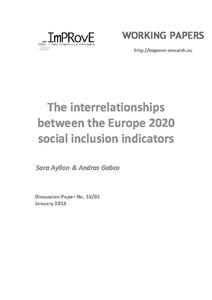The interrelationships between the Europe 2020 - social inclusion indicators
"The aim of this paper is to dynamically analyse the three indicators of poverty and social exclusion covered by the EU2020 poverty target, while focusing on state dependence and feedback effects. We are interested in learning to what extent being at risk of poverty, severe material deprivation...
| Main Authors: | , , |
|---|---|
| Institution: | ETUI-European Trade Union Institute |
| Format: | TEXT |
| Language: | English |
| Published: |
Antwerp
2015
ImPRovE |
| Subjects: | |
| Online Access: | https://www.labourline.org/KENTIKA-19115403124919336859-The-interrelationships-between.htm |
| Summary: | "The aim of this paper is to dynamically analyse the three indicators of poverty and social exclusion covered by the EU2020 poverty target, while focusing on state dependence and feedback effects. We are interested in learning to what extent being at risk of poverty, severe material deprivation or low work intensity in one year is related to being in the same status one year later and if being in a given status predicts the occurrence of one of the others in subsequent periods. Our results indicate that the three social indicators of the EU2020 strategy are capturing different aspects of economic hardship in the majority of European countries analysed. We show that the three processes are affected by a considerable degree of genuine state dependence but weak evidence for one-year lagged feedback effects (with the exception of the Central-Eastern European countries where feedback loops between the three segments are found. Mostly, interrelationships occur via current effects, initial conditions and correlated unobserved heterogeneity. In terms of policy implications, our results suggest that the three phenomena should be handled by different interventions while expecting spill-over effects across time to be marginal." |
|---|---|
| Physical Description: | 27 p. Digital |

